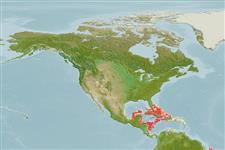Classification / Names
ชื่อสามัญ | ชื่อพ้อง | Catalog of Fishes(สกุล, ชนิด) | ITIS | CoL | WoRMS | Cloffa
>
Gobiiformes (Gobies) >
Gobiidae (Gobies) > Gobiinae
Etymology: Paedovaricus: Name from the root word ‘paed-’ (English spelling of the Greek root ‘ped-’, meaning ‘child’), combined with Varicus, referring to the small size of the type species and its general similarity to the genus Varicus..
More on author: Greenfield.
Environment: milieu / climate zone / depth range / distribution range
นิเวศวิทยา
เกี่ยวกับทะเล,น้ำเค็ม สัตว์น้ำหน้าดิน; ระดับความลึก 15 - 91 m (Ref. 92840). Tropical
Western Atlantic: Eleuthera Islands, Bahamas; Carrie Bow Cay, Belize.
ขนาด / น้ำหนัก / Age
Maturity: Lm ? range ? - ? cm
Max length : 1.4 cm SL เพศผู้/กระเทย; (Ref. 92840)
Short description
สัณฐานวิทยา | ความยาวต่างๆ
เงี่ยงครีบหลัง (รวม): 8; ก้านครีบอ่อนที่หาง (รวม): 7; เงี่ยงครีบก้น 1; ก้านครีบอ่อนที่ก้น: 7; สัตว์มีกระดูกสันหลัง: 27. Distinguished by the following characters: possesses all taxonomic characters present in most members of Gobiosomatini and Gobiosoma group (D1 VII, pterygiophore insertion pattern of 3-221110, vertebrae 27 with precaudal 11 and caudal 16, hypurals 1 and are 2 fused to some extent with hypurals 3 and 4 and the terminal vertebral element, 1 epural); pelvic fins are well separated, without both anterior frenum and well-developed membrane connecting innermost rays; pelvic-fin rays 1-5 unbranched, no flattened or fleshy tips; pelvic-fin rays very long, fourth ray extend posteriorly to origin of last anal-fin ray or beyond; scales on body (modified basicaudal scales present); an anal-fin pterygiophore inserted before first haemal spine, no cephalic lateralis canals and pores; D2 I,7; A I,7;body, head, and fins have a light yellowish orange hue, with diffuse dark vertical bars alongside of body, and very dark wide vertical band over posterior end of caudal peduncle and on the base of the caudal rays (Ref. 113825).
Rare in collections that little is known about the distribution and ecology (Ref. 92840).
Life cycle and mating behavior
วัยเจริญพันธุ์ | การสืบพันธุ์ | การวางไข่ | เซลสืบพันธ์ของเพศเมีย(ไข่) | ความดกของไข่ | ตัวอ่อน
Smith, C.L., 1997. National Audubon Society field guide to tropical marine fishes of the Caribbean, the Gulf of Mexico, Florida, the Bahamas, and Bermuda. Alfred A. Knopf, Inc., New York. 720 p. (Ref. 26938)
IUCN Red List Status (Ref. 130435)
Threat to humans
Harmless
Human uses
ข้อมูลเพิ่มเติม
ชื่อสามัญชื่อพ้องกลไกการเผาผลาญพลังงานผู้ล่าการศึกษาเกี่ยวกับผลกระทบของสารประกอบทางเคมีที่เป็นอันตรายต่อสิ่งมีชีวิต ประชากร และสิ่งแวดล้อมการสืบพันธุ์วัยเจริญพันธุ์การวางไข่การรวมกลุ่มวางไข่ความดกของไข่เซลสืบพันธ์ของเพศเมีย(ไข่)Egg development
Age/SizeการเจริญเติบโตLength-weightLength-lengthLength-frequenciesความยาวต่างๆสัณฐานวิทยาตัวอ่อนพลวัตของสัตว์น้ำวัยอ่อนการทดแทนที่อุดมสมบรูณ์BRUVS
อ้างอิงการเพาะเลี้ยงสัตว์น้ำประวัติการเพาะเลี้ยงสัตว์น้ำสายพันธุ์พันธุศาสตร์ElectrophoresesอัตราพันธุกรรมโรคการแปรรูปNutrientsMass conversion
ผู้ร่วมมือรูปภาพหลายรูปStamps, Coins Misc.เสียงปลามีพิษ เช่น ปลาปักเป้าความเร็วรูปแบบการว่ายน้ำพื้นที่เหงือกOtolithsสมองวิสัยทัศน์
เครื่องมือ
Special reports
Download XML
แหล่งที่มาจากอินเตอร์เน็ต
Estimates based on models
Preferred temperature (Ref.
123201): 23.6 - 27.6, mean 25.7 °C (based on 47 cells).
Phylogenetic diversity index (Ref.
82804): PD
50 = 1.0000 [Uniqueness, from 0.5 = low to 2.0 = high].
Bayesian length-weight: a=0.00708 (0.00333 - 0.01504), b=3.09 (2.92 - 3.26), in cm total length, based on LWR estimates for this (Sub)family-body shape (Ref.
93245).
ระดับชั้นอาหาร (Ref.
69278): 3.0 ±0.3 se; based on size and trophs of closest relatives
ความสามารถในการกลับคืนสู่ปกติ (Ref.
120179): ความสูง, เวลาต่ำสุดที่จะทำให้ประชากรเพิ่มขึ้นเป็น 2 เท่าใช้เวลาน้อยกว่า 15 เดือน (Preliminary K or Fecundity.).
Fishing Vulnerability (Ref.
59153): Low vulnerability (10 of 100).
